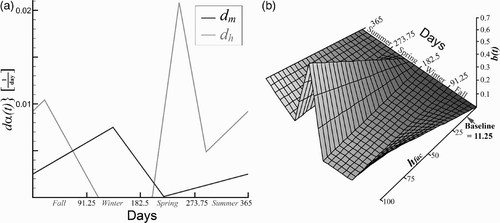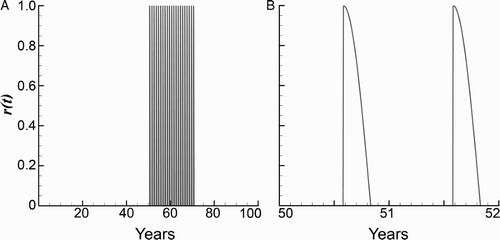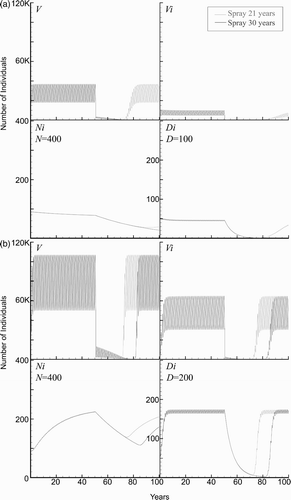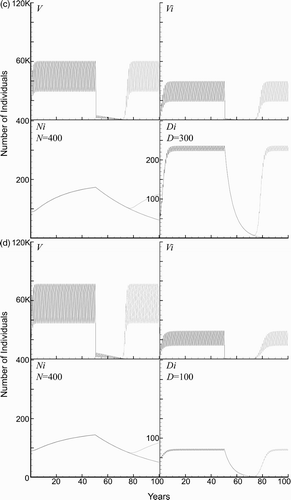Figures & data
Figure 1. Schematic of the major variables in the model. It depicts the interactions among the vectors (V), the infected vectors (V i ), and the various blood sources. While chickens (C) are a preferred blood source (4.8×over humans (N)), they cannot harbour the parasite. Dogs (D) are preferred over humans (2.45×) and play a significant role in transmission. Housing plays a role in providing reservoirs for vectors to survive insecticide treatment. Wildlife [wtilde] also can contribute to perpetuate disease transmission, but was not considered in the simulations.
![Figure 1. Schematic of the major variables in the model. It depicts the interactions among the vectors (V), the infected vectors (V i ), and the various blood sources. While chickens (C) are a preferred blood source (4.8×over humans (N)), they cannot harbour the parasite. Dogs (D) are preferred over humans (2.45×) and play a significant role in transmission. Housing plays a role in providing reservoirs for vectors to survive insecticide treatment. Wildlife [wtilde] also can contribute to perpetuate disease transmission, but was not considered in the simulations.](/cms/asset/c2b17b21-8013-4d0f-acae-685506ffb18c/tjbd_a_505985_o_f0001g.gif)
Table 1. The model parameters, baseline simulation values, and the sources.
Figure 2. Parameters for total vectors. (a) Growth d hτ(t) and mortality d m (t) rates are piecewise linear functions. The growth rate is directly proportional to the biting rate since egg production requires a blood meal. (b) The biting rate b(t) varies with the seasons and with the blood supply (human factors) Citation5 Citation6. The biting rate is linear relative to the blood supply and piecewise linear when the blood supply is fixed. The biting rate varies due to seasonal temperate changes in temperate regions.

Figure 3. The spraying function r(t). (a) All spraying simulations begin at year 50 and continue yearly for 21 or 30 years. (b) Close-up of spraying from years 50–60. Spraying occurs once a year (in spring) and the insecticide's effectiveness decays exponentially over a period of three months. The model assumes that the average home has cracks/reservoirs that allow initially 20 vectors to survive, the surviving number deceasing each spray cycle.

Figure 4. Baseline simulation of total number of vectors (V(t)) in the village (four humans, one dog, one chicken per home in a village of 100 homes) over 100 years. (a) A stable model vector population. (b) Seasonality of the vectors, years 50–52. The vector population reaches its maximum in fall and the minimum in late winter. The vector population fluctuations are due to growth and mortality (shown in ). (c) Baseline simulation of total number of vectors (V(t)) in the village with spraying during years 50–71. (d) Seasonality of the vectors, years 50–52 during the initiation of spraying in year 50 during spring.

Figure 5. Spraying simulation of vectors (V), infected vectors (V i ), infected humans (N i ), and infected dogs (D i ) are graphed over 100 years. (a) The baseline population (village) underwent 21 or 30 years of successive spraying. After cessation of insecticide use after 21 years, the number of triatomids in the village returns to the pre-spray population in 5–10 years. Due to the extended life span of humans, the infection is still present in the population and re-establishes over time. The infections’ return in each species varies due to the lifespan/turnover rate. After 30 years, the domestic triatomids have been eradicated from the village. (b) Spraying simulation of increased blood supply to two dogs and five chickens per household. The population (village) underwent 21 or 30 years of successive spraying. After cessation of insecticide at both 21 and 30 years, the number of triatomids in the village return to the pre-spray population. (c) Effects of number of dogs per household. Increased number of dogs per household to 3 or 300 per village. (d) Effects of number of chickens per household. Increased number of chickens per household to 3 or 300 per village.

